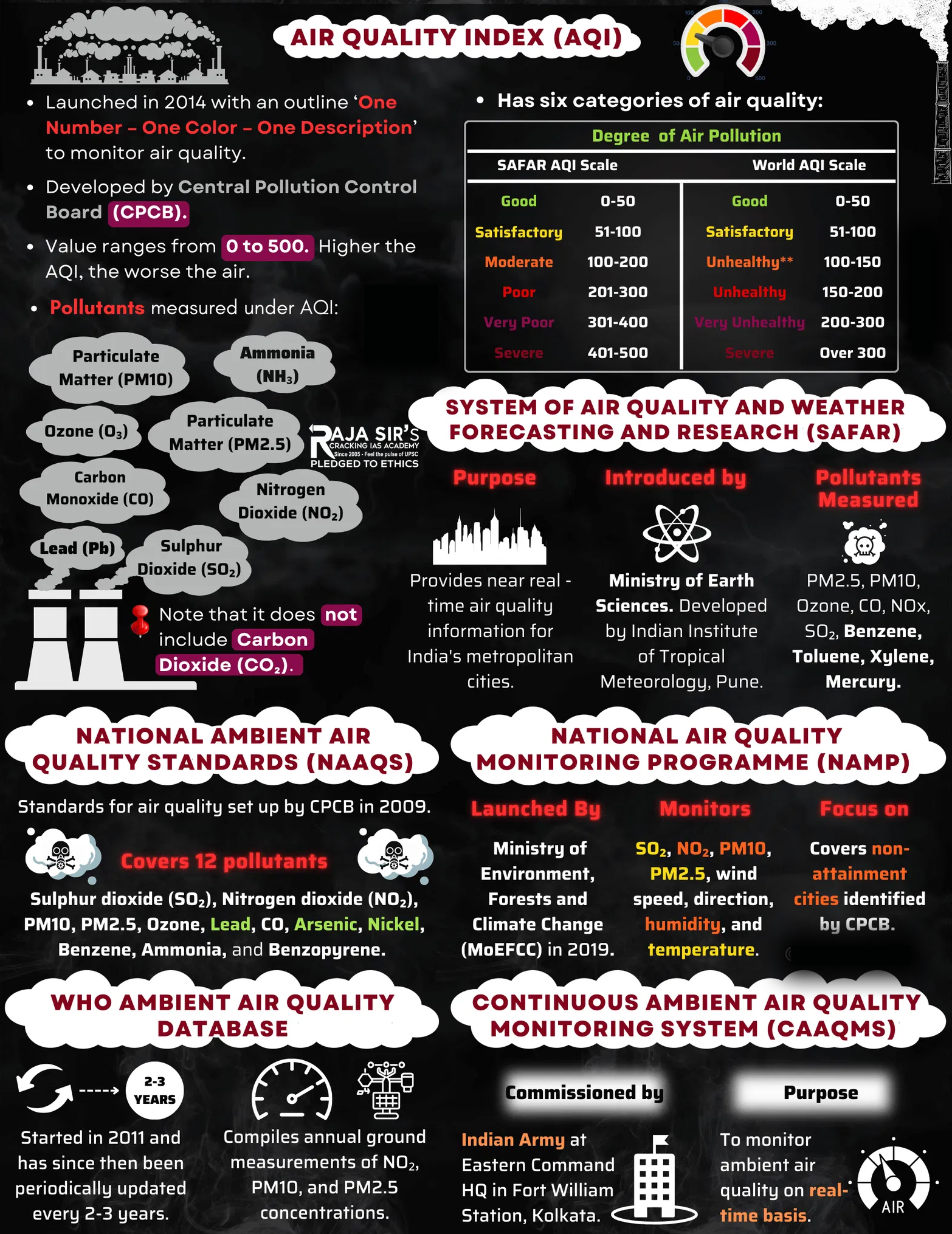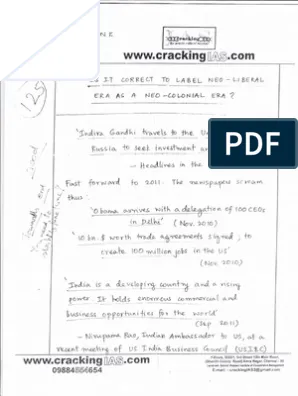- Home
- Prelims
- Mains
- Current Affairs
- Study Materials
- Test Series
 EDITORIALS & ARTICLES
EDITORIALS & ARTICLES
Why Delhi Chokes: A Clear Guide to Air Pollution and Its Solutions
Air pollution is the introduction of chemicals, particulates or biological materials into the atmosphere that cause discomfort, disease, or death to humans. In India, air pollution is measured according to the National Air Quality Index developed by Central Pollution Control Board (CPCB) in 2014.
The measurement of air quality in the NAQI framework is based on eight pollutants, namely- Particulate Matter (PM10), Particulate Matter (PM2.5), Nitrogen Dioxide (NO2), Sulphur Dioxide (SO2), Carbon Monoxide (CO), Ozone (O3), Ammonia (NH3) and Lead (Pb).
 Reasons for the rise in air pollution in Delhi
Reasons for the rise in air pollution in Delhi
- Stubble Burning:Stubble burning in Punjab, Rajasthan, and Haryana emits large amounts of toxic pollutants in the atmosphere. These pollutants contain harmful gases like methane (CH4), carbon monoxide (CO), volatile organic compounds (VOC) and carcinogenic polycyclic aromatic hydrocarbons. The IIT consortium report have estimated that stubble burning contributed up to 35% of Delhi’s PM 2.5 levels during the peak October-November season.
- Reduced Wind Speed: Low-speed winds in winters are unable to disperse these pollutants effectively. Further, Delhi lies in a landlocked region and does not have the geographical advantage of sea breeze to disperse the suspended pollutants.
- Effect of Northwesterly winds: After the withdrawal of monsoons, the predominant direction of winds in northern India is northwesterly. These northwesterly winds bring the dust from the gulf region, northern Pakistan and Afghanistan.
- Dip in Temperatures lowers the inversion height: With the decrease in temperature, inversion height lowers down, leading to concentration of pollutants in the lower atmosphere. (Inversion height is the layer beyond which pollutants cannot disperse into the upper layer of the atmosphere).
- Vehicular Pollution:Delhi has one of the highest number of registered private vehicles in India. Official emissions inventories of 2018 show that vehicles emit about 40 per cent of the particulate load in the city of Delhi.
- Construction Activities and Open Waste Burning: Pollution due to landfill burning and construction debris enhances the pollution levels in the Delhi NCR region.
- Firecrackers:Firecrackers burning during Diwali further adds to the increase in air pollution levels.
- Urban development strategy in India:The current strategy focuses on real estate development, a widening of roads and allowing large fuel guzzling vehicles which are major reasons for increased pollution.
- Expansion of ‘Grey’ infrastructure:Water bodies, urban forests, green cover, and urban agriculture have all reported shrinkage, and “grey” infrastructure has seen rapid expansion.
- Land use change: The handing over of open spaces to real estate developers and lack of any meaningful afforestation affects the city’s ecology.
- Promotion of car sales:Widening roads induces people to buy more cars, thus leading to more pollution levels.
- Construction activities: It contributes roughly 10% of air pollution in Delhi-NCR. There are hardly any steps being taken to monitor construction activities.
Effects
The harmful effects of air pollution have been tabulated below:
|
Economic effects |
(1) Leads to loss of labour productivity, GDP and per capita income levels. (The Confederation of Indian Industry estimates that air pollution costs Indian businesses $95 billion, or 3 per cent of India’s GDP every year). (Poor air amounts to about Rs 7 lakh crore of annual economic loss, which is more than a third of our annual GST collection) |
|
Human Health Effects |
(1) Air pollution leads to multiple health conditions including respiratory infections, heart disease and lung cancer. |
|
Environment |
(1) Acid Rain: Damages crops, natural vegetation, soil chemistry and leads to damage to ancient monuments (Taj Mahal Yellowing). |
Govt initiatives
- Cloud Seeding (Artificial Rain):Piloted with IIT Kanpur, three rounds were conducted in 2025 to temporarily reduce airborne particulate matter, although results were mixed due to weather constraints. The key reason for limited results was insufficient cloud moisture (only 15–20%), while successful cloud seeding typically requires 50% or more. High cloud bases (near 10,000 feet) also reduced effectiveness.
- Crop Residue Management Scheme:Crop Residue Management (CRM) scheme which provides subsidy to farmers for buying ‘Turbo Happy Seeder‘, ‘Super SMS attachment’, ‘rotavators‘ and ‘superseeder’.
- Commission for Air Quality Management (CAQM):CAQM is a statutory body formed under the Commission for Air Quality Management in National Capital Region and Adjoining Areas, Act 2021. CAQM has provided a framework to tackle the problem of air pollution due to stubble burning.
- Initiatives to reduce Vehicular Pollution:The shift from BS-IV to BS-VI, push for Electric Vehicles (EVs), Odd-even Policy have all been implemented to reduce Vehicular pollution.
- Graded Response Action Plan (GRAP): GRAP measures like shutting down thermal power plants and a ban on construction activities are implemented to curb air pollution.
- Dust and construction controls:Mandatory deployment of anti-smog guns and water sprinklers at large buildings, construction sites, and hotspots; mist sprayers installed on electric poles at 13 major air pollution hotspots.
Road ahead
A start has been made to recognise the severity of air pollution on the health of the population and the economy. Delhi and Mumbai are the two financial backbones of our country. The following measures need to be undertaken to curb air pollution in Delhi and Mumbai:
- Increase the AQI monitoring stations:The adequate numbers of AQI monitoring stations as mandated by the National Clean Air Programme (NCAP) must be installed. Also, sensor based AQI monitoring units that give hyperlocal data must be set up.
- Enhanced powers to the authorities to take action according to the hyperlocal data: It will help the authorities take pre-emptive actions and allow denser monitoring. For example, if it is found that construction is taking place in a certain pocket without following norms, the authorities can identify the location and immediately penalise the violators.
- National Nodal Authority for Air pollution: India needs a nodal authority with constitutional powers to ensure collaborative pre-emptive action on air pollution with timelines for all stakeholders.
- Setting up Independent commissions for management of AQI: Independent commissions like the Commission for Air Quality Management (CAQM) for NCR and adjoining regions, should be set up in other major cities like Mumbai and Chennai. It will help in taking actions against the violators irrespective of the geographical region. Regional or airshed approach must be used to counter the geographical challenge to air pollution management as done in Los Angeles, Mexico City and many mega-urban regions in China.
- Stricter guidelines for industrial emissions:SEBI’s Business Responsibility and Sustainability Report (BRSR) framework can lay down tighter guidelines to ensure uniformity in the unit of reporting pollutant emissions, declaration of air pollution mitigation targets (like companies do for carbon emissions), and reporting of disaggregated emissions data. We must reduce exposure across the value chain from production to consumption to recycling of goods and delivery of services.
- Making ‘Clean air’ an investment sector: The push for substitution of fossil fuels will increase investment opportunities in clean energy transition sector like green mobility, clean cooking. This will open up a new sector for investment and will help in reducing the air pollution simultaneously.
- Funds and Manpower Training to combat pollution:The Sixteenth Finance commission should provide finance to urban local bodies for climate change and air pollution reduction interventions. The urban local bodies manpower must be properly trained and the dysfunctional State pollution Control Boards must be empowered to take punitive actions.
- Increased awareness and incentive for civil society: Different stakeholders need to know why cleaning the air will benefit their livelihoods and businesses. For instance, farmers will not curb stubble burning until a viable circular economy for alternative uses of biomass emerges. We must adopt sustainable lifestyles which are in line with government’s LiFE initiative.
- Increased use of Public transport and reduced dependence on private vehicles:The Delhi Master Plan target of 80 per cent of motorised trips by public transport by 2020 has not been met yet. The deadline has been shifted to 2041. This deadline needs to be met by augmenting the public transport system. The private vehicles use must be disincentivized by introducing ward-wise parking management area plans and parking tax.
- Limit crop residue burning: We must implement known solutions like shifting to less water-intensive crops, altering irrigation arrangements, timing, harvesting, baling practices and building a wider year-round market for straw.
- End-to-end construction and waste management:It is pivotal to reducing tonnes of dust and waste released in the air and water bodies.
- Learnings from London, China, Singapore, Hong Kong must be incorporated:London does not allow private vehicles in areas well-connected by public transport. China uses ‘fixed number of car sales per year‘ in Beijing. We must improve the public transport like London, China, Singapore and Hong-Kong.
Air pollution in Delhi is not caused by one single source — it is a result of vehicles, industries, construction dust, stubble burning, and weather conditions. Solving the crisis requires a coordinated effort from the central government, state governments, industries, and the public. Sustainable policies, technological solutions, and behavioral changes are essential to ensure cleaner air for the future.









 Latest News
Latest News General Studies
General Studies